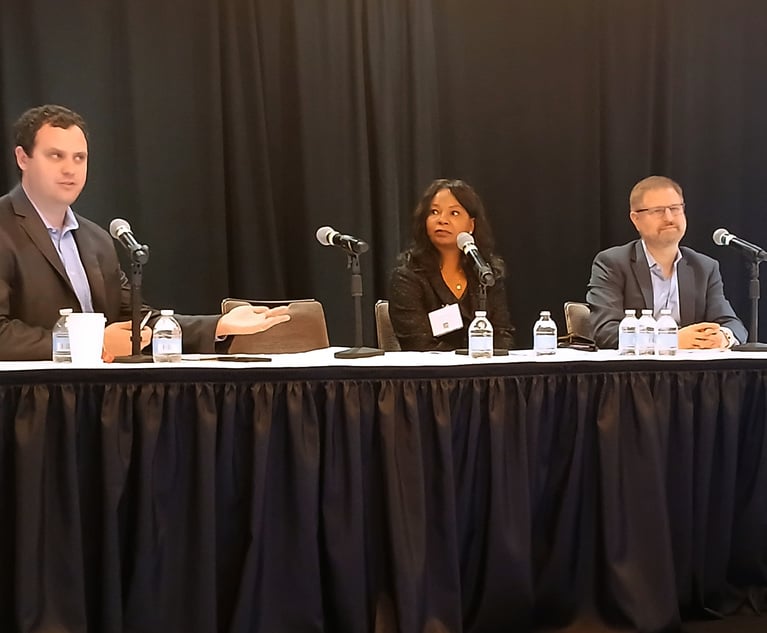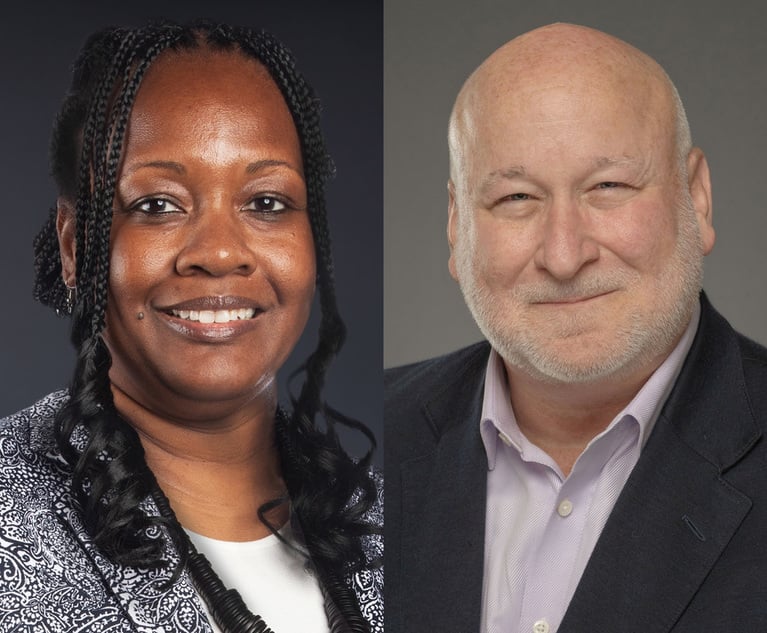Process Makes Perfect: Managing In-House Attorney-Client Privilege
Implementing proper procedures helps protect legal departments from privilege violations.
February 28, 2010 at 07:00 PM
7 minute read
In my last column, “Proper Practices,” I described two action items I recommend to ensure that your in-house team is managing the attorney-client privilege. In this article, I offer the additional steps.
After making sure your team is properly trained and is educating your business teams on attorney-client privilege, you should develop and implement a standard internal investigation process. The actions you take in the first 48 hours after an issue arises are critical to the internal investigation's effectiveness. The conduct of in-house counsel during this time can preserve or destroy the attorney-client privilege.
Many law departments mistakenly assume their lawyers are well prepared to manage the early stages of an investigation, including the tricky initial interaction with an employee bringing an issue to the attorney's attention. Case law is littered with examples of privilege being compromised by improper handling of employee interviews. Legal department leaders should develop a durable investigation process.
An essential component of the investigative process is the “Upjohn warning,” which clarifies to an employee being interviewed that the attorney is representing the corporation and not the individual. Establishing this relationship at the outset precludes the employees from reasonably asserting ownership of the privilege relating to interactions with in-house counsel.
When delivering an Upjohn warning, a formal investigation process and training prepare in-house counsel for managing an internal investigation, including the critical early stage, and preserve the privilege for the organizational client.
The fourth thing you can do is internalize the lessons of Coastal States Gas Corp. v. Department of Energy and Exxon v. Department of Conservation and Natural Resources. These cases remind us that privileged exchanges remain so only if the communications are treated as confidential and are not indiscriminately circulated within an organization. Courts have recognized the need to share privileged communications with “need-to-know” agents without waiving the privilege. Before you hit the send button, test yourself: Can you articulate the “need-to-know” justification for each recipient? In Exxon, a multibillion-dollar verdict against Exxon (and its ultimate reversal) was tied to a determination of whether the recipients of an in-house lawyer's memorandum had “need-to-know” status. How would your communications fare under such scrutiny?
Finally, courts continue to remind us that the privilege applies only to legal advice. The rendering of business advice, even from an attorney, is not subject to the privilege. Courts have particular difficulty evaluating the application of the privilege to communications with mixed purposes. In such cases, courts will look for the predominate purpose of the communication, if one can be identified. Often, impatient courts will reject protection of hopelessly entangled business and legal advice. For example, in In re Vioxx Products Liability Litigation, Merck & Co. asserted privilege over approximately 30,000 documents. Looking at the primary purpose of the communications, the court advised that “this [rule] cannot be gotten around by the simple expedient of putting a lawyer in the shoes of the executive or … giving the legal department the power of the corporate executive.”
As in-house counsel, I urge you to to classify your communications in order to elucidate the purpose of each communication. I often preface my legal advice with a notation that counsel is rendering legal advice. Also, rather than mixing business and legal advice in a single communication, you may want to send separate communications. The bottom line is to draft your communications in a way that makes it easy for a court to apply the privilege.
In my last column, “Proper Practices,” I described two action items I recommend to ensure that your in-house team is managing the attorney-client privilege. In this article, I offer the additional steps.
After making sure your team is properly trained and is educating your business teams on attorney-client privilege, you should develop and implement a standard internal investigation process. The actions you take in the first 48 hours after an issue arises are critical to the internal investigation's effectiveness. The conduct of in-house counsel during this time can preserve or destroy the attorney-client privilege.
Many law departments mistakenly assume their lawyers are well prepared to manage the early stages of an investigation, including the tricky initial interaction with an employee bringing an issue to the attorney's attention. Case law is littered with examples of privilege being compromised by improper handling of employee interviews. Legal department leaders should develop a durable investigation process.
An essential component of the investigative process is the “Upjohn warning,” which clarifies to an employee being interviewed that the attorney is representing the corporation and not the individual. Establishing this relationship at the outset precludes the employees from reasonably asserting ownership of the privilege relating to interactions with in-house counsel.
When delivering an Upjohn warning, a formal investigation process and training prepare in-house counsel for managing an internal investigation, including the critical early stage, and preserve the privilege for the organizational client.
The fourth thing you can do is internalize the lessons of Coastal States Gas Corp. v. Department of Energy and Exxon v. Department of Conservation and Natural Resources. These cases remind us that privileged exchanges remain so only if the communications are treated as confidential and are not indiscriminately circulated within an organization. Courts have recognized the need to share privileged communications with “need-to-know” agents without waiving the privilege. Before you hit the send button, test yourself: Can you articulate the “need-to-know” justification for each recipient? In Exxon, a multibillion-dollar verdict against Exxon (and its ultimate reversal) was tied to a determination of whether the recipients of an in-house lawyer's memorandum had “need-to-know” status. How would your communications fare under such scrutiny?
Finally, courts continue to remind us that the privilege applies only to legal advice. The rendering of business advice, even from an attorney, is not subject to the privilege. Courts have particular difficulty evaluating the application of the privilege to communications with mixed purposes. In such cases, courts will look for the predominate purpose of the communication, if one can be identified. Often, impatient courts will reject protection of hopelessly entangled business and legal advice. For example, in In re Vioxx Products Liability Litigation,
As in-house counsel, I urge you to to classify your communications in order to elucidate the purpose of each communication. I often preface my legal advice with a notation that counsel is rendering legal advice. Also, rather than mixing business and legal advice in a single communication, you may want to send separate communications. The bottom line is to draft your communications in a way that makes it easy for a court to apply the privilege.
This content has been archived. It is available through our partners, LexisNexis® and Bloomberg Law.
To view this content, please continue to their sites.
Not a Lexis Subscriber?
Subscribe Now
Not a Bloomberg Law Subscriber?
Subscribe Now
NOT FOR REPRINT
© 2024 ALM Global, LLC, All Rights Reserved. Request academic re-use from www.copyright.com. All other uses, submit a request to [email protected]. For more information visit Asset & Logo Licensing.
You Might Like
View All
GC Conference Takeaways: Picking AI Vendors 'a Bit of a Crap Shoot,' Beware of Internal Investigation 'Scope Creep'
8 minute read
Why ACLU's New Legal Director Says It's a 'Good Time to Take the Reins'

'Utterly Bewildering': GCs Struggle to Grasp Scattershot Nature of Law Firm Rate Hikes
Trending Stories
- 1NY Appellate Panel Cites Student's Disciplinary History While Sending Negligence Claim Against School District to Trial
- 2A Meta DIG and Its Nvidia Implications
- 3Deception or Coercion? California Supreme Court Grants Review in Jailhouse Confession Case
- 4State Bar of Georgia Presents Access to Justice Pro Bono Awards
- 5Tips For Creating Holiday Plans That Everyone Can Be Grateful For
Who Got The Work
Michael G. Bongiorno, Andrew Scott Dulberg and Elizabeth E. Driscoll from Wilmer Cutler Pickering Hale and Dorr have stepped in to represent Symbotic Inc., an A.I.-enabled technology platform that focuses on increasing supply chain efficiency, and other defendants in a pending shareholder derivative lawsuit. The case, filed Oct. 2 in Massachusetts District Court by the Brown Law Firm on behalf of Stephen Austen, accuses certain officers and directors of misleading investors in regard to Symbotic's potential for margin growth by failing to disclose that the company was not equipped to timely deploy its systems or manage expenses through project delays. The case, assigned to U.S. District Judge Nathaniel M. Gorton, is 1:24-cv-12522, Austen v. Cohen et al.
Who Got The Work
Edmund Polubinski and Marie Killmond of Davis Polk & Wardwell have entered appearances for data platform software development company MongoDB and other defendants in a pending shareholder derivative lawsuit. The action, filed Oct. 7 in New York Southern District Court by the Brown Law Firm, accuses the company's directors and/or officers of falsely expressing confidence in the company’s restructuring of its sales incentive plan and downplaying the severity of decreases in its upfront commitments. The case is 1:24-cv-07594, Roy v. Ittycheria et al.
Who Got The Work
Amy O. Bruchs and Kurt F. Ellison of Michael Best & Friedrich have entered appearances for Epic Systems Corp. in a pending employment discrimination lawsuit. The suit was filed Sept. 7 in Wisconsin Western District Court by Levine Eisberner LLC and Siri & Glimstad on behalf of a project manager who claims that he was wrongfully terminated after applying for a religious exemption to the defendant's COVID-19 vaccine mandate. The case, assigned to U.S. Magistrate Judge Anita Marie Boor, is 3:24-cv-00630, Secker, Nathan v. Epic Systems Corporation.
Who Got The Work
David X. Sullivan, Thomas J. Finn and Gregory A. Hall from McCarter & English have entered appearances for Sunrun Installation Services in a pending civil rights lawsuit. The complaint was filed Sept. 4 in Connecticut District Court by attorney Robert M. Berke on behalf of former employee George Edward Steins, who was arrested and charged with employing an unregistered home improvement salesperson. The complaint alleges that had Sunrun informed the Connecticut Department of Consumer Protection that the plaintiff's employment had ended in 2017 and that he no longer held Sunrun's home improvement contractor license, he would not have been hit with charges, which were dismissed in May 2024. The case, assigned to U.S. District Judge Jeffrey A. Meyer, is 3:24-cv-01423, Steins v. Sunrun, Inc. et al.
Who Got The Work
Greenberg Traurig shareholder Joshua L. Raskin has entered an appearance for boohoo.com UK Ltd. in a pending patent infringement lawsuit. The suit, filed Sept. 3 in Texas Eastern District Court by Rozier Hardt McDonough on behalf of Alto Dynamics, asserts five patents related to an online shopping platform. The case, assigned to U.S. District Judge Rodney Gilstrap, is 2:24-cv-00719, Alto Dynamics, LLC v. boohoo.com UK Limited.
Featured Firms
Law Offices of Gary Martin Hays & Associates, P.C.
(470) 294-1674
Law Offices of Mark E. Salomone
(857) 444-6468
Smith & Hassler
(713) 739-1250







